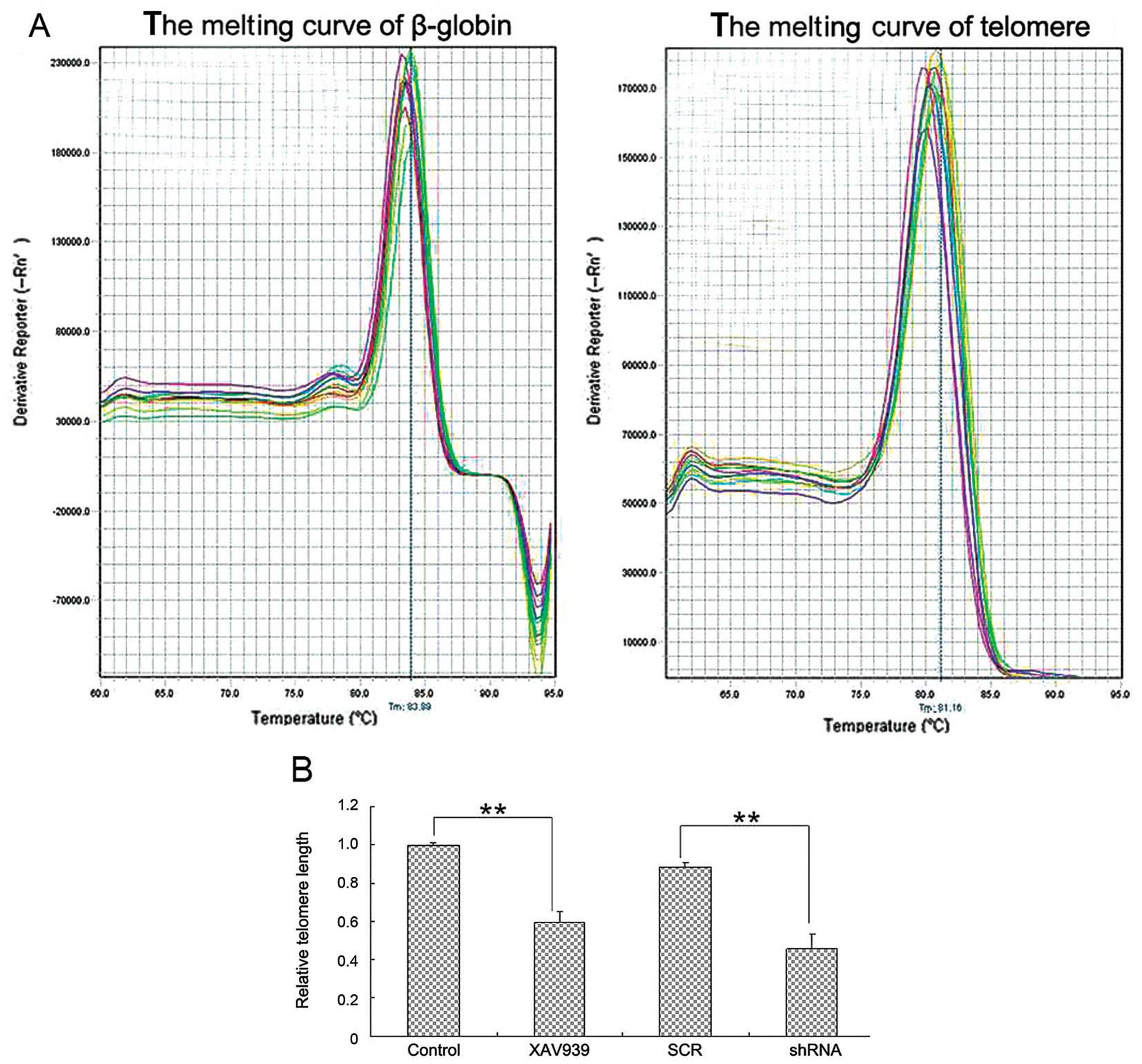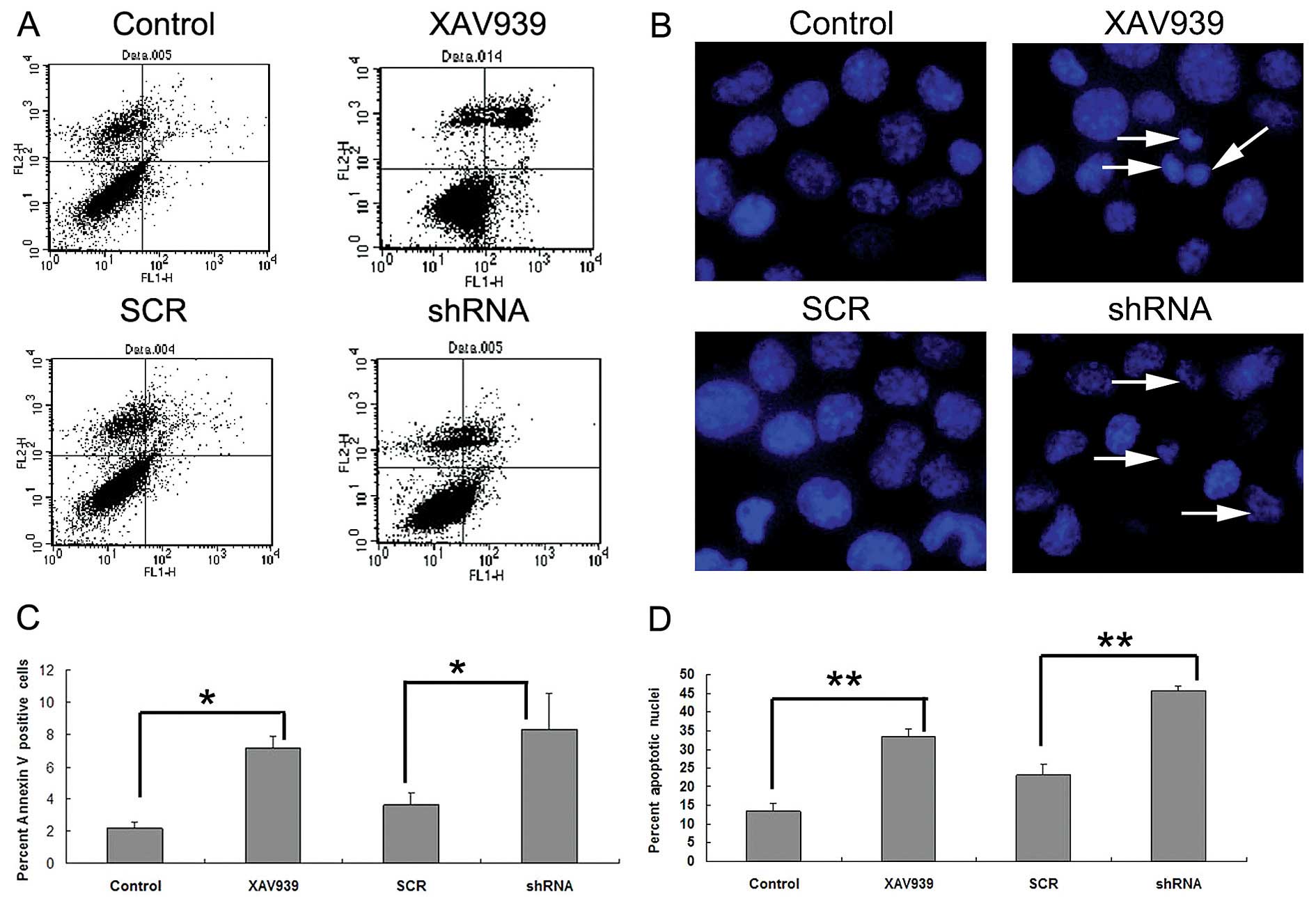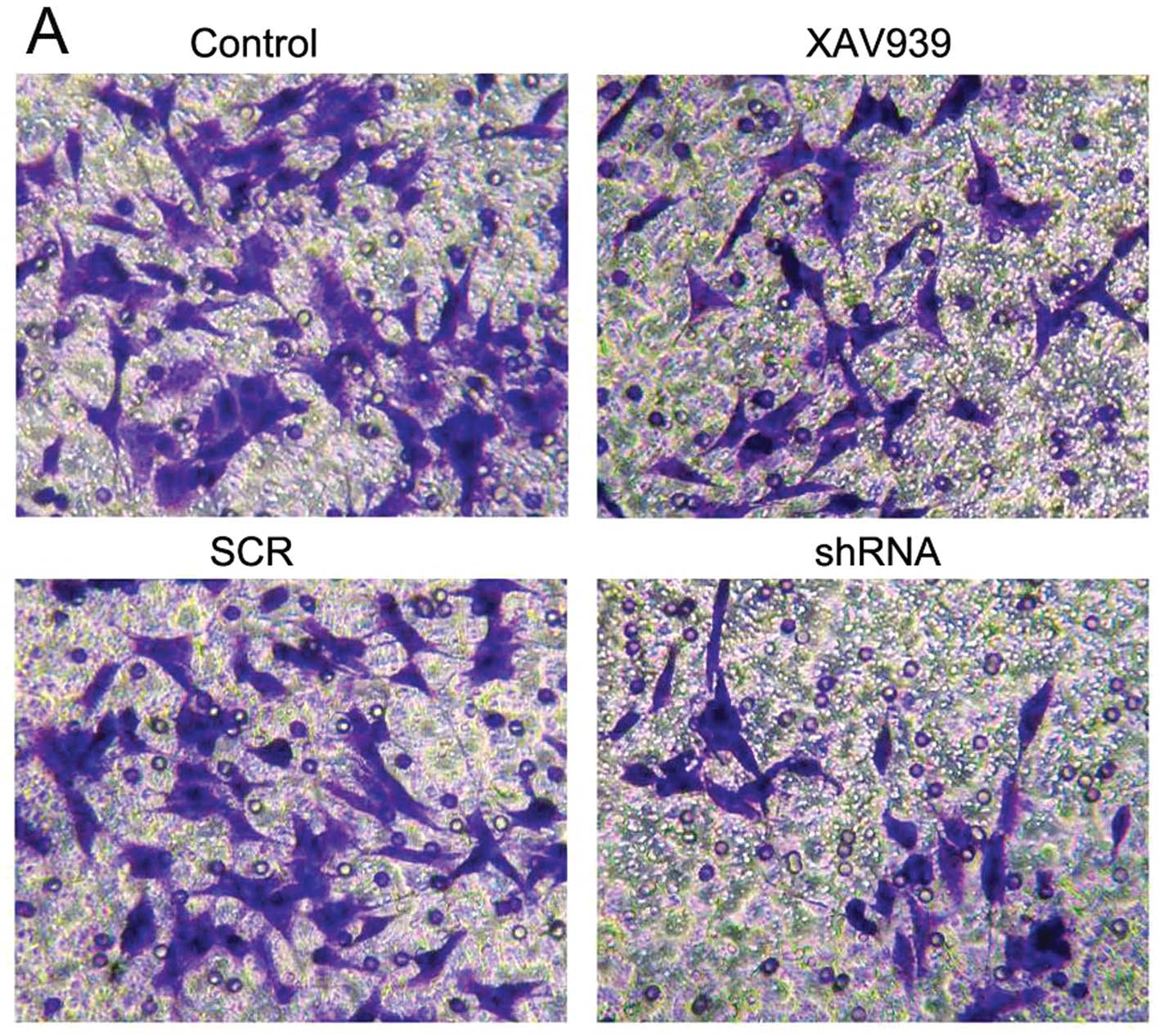|
1
|
Ramirez R, Carracedo J, Jiménez R, et al:
Massive telomere loss is an early event of DNA damage-induced
apoptosis. J Biol Chem. 278:836–842. 2003. View Article : Google Scholar : PubMed/NCBI
|
|
2
|
Lyons RJ, Deane R, Lynch DK, Ye ZS,
Sanderson GM, Eyre HJ, Sutherland GR and Daly RJ: Identification of
a novel human tankyrase through its interaction with the adaptor
protein Grbl4. J Biol Chem. 276:17172–17180. 2001. View Article : Google Scholar : PubMed/NCBI
|
|
3
|
De Rycker M, Venkatesan RN, Wei C and
Price CM: Vertebrate tankyrase domain structure and sterile α motif
(SAM)-mediated multimerization. Biochem J. 372:87–96. 2003.
|
|
4
|
Seimiya H, Muramatsu Y, Smith S and Tsuruo
T: Functional subdomain in the ankyrin domain of tankyrase 1
required for poly(ADP-ribosyl)ation of TRF1 and telomere
elongation. Mol Cell Biol. 24:1944–1955. 2004. View Article : Google Scholar : PubMed/NCBI
|
|
5
|
De Rycker M and Price CM: Tankyrase
polymerization is controlled by its sterile α motif and
poly(ADP-ribose) polymerase domains. Mol Cell Biol. 24:9802–9812.
2004.PubMed/NCBI
|
|
6
|
Kaminker PG, Kim SH, Taylor RD,
Zebarjadian Y, Funk WD, Morin GB, Yaswen P and Campisi J: TANK2, a
new TRF1-associated poly(ADP-ribose) polymerase, causes rapid
induction of cell death upon overexpression. J Biol Chem.
276:35891–35899. 2001. View Article : Google Scholar : PubMed/NCBI
|
|
7
|
Seimiya H: The telomeric PARP, tankyrases,
as targets for cancer therapy. Br J Cancer. 94:341–345. 2006.
View Article : Google Scholar : PubMed/NCBI
|
|
8
|
Smith S, Giriat I, Schmitt A and de Lange
T: Tankyrase, a poly(ADP-ribose) polymerase at human telomeres.
Science. 282:1484–1487. 1998. View Article : Google Scholar : PubMed/NCBI
|
|
9
|
Hsiao SJ and Smith S: Sister telomeres
rendered dysfunctional by persistent cohesion are fused by NHEJ. J
Cell Biol. 184:515–526. 2009. View Article : Google Scholar : PubMed/NCBI
|
|
10
|
Papeo G, Forte B, Orsini P, Perrera C,
Posteri H, Scolaro A and Montagnoli A: Poly(ADP-ribose) polymerase
inhibition in cancer therapy: are we close to maturity? Expert Opin
Ther Pat. 19:1377–1400. 2009. View Article : Google Scholar : PubMed/NCBI
|
|
11
|
Muramatsu Y, Ohishi T, Sakamoto M, Tsuruo
T and Seimiya H: Cross-species difference in telomeric function of
tankyrase 1. Cancer Sci. 98:850–857. 2007. View Article : Google Scholar : PubMed/NCBI
|
|
12
|
Lu R, Pal J, Buon L, et al: Targeting
homologous recombination and telomerase in Barrett’s
adenocarcinoma: impact on telomere maintenance, genomic instability
and tumor growth. Oncogene. 33:1495–1505. 2014.PubMed/NCBI
|
|
13
|
Seimiya H, Muramatsu Y, Ohishi T and
Tsuruo T: Tankyrase 1 as a target for telomere-directed molecular
cancer therapeutics. Cancer Cell. 7:25–37. 2005. View Article : Google Scholar : PubMed/NCBI
|
|
14
|
Tian XH, Hou WJ, Fang Y, Fan J, Tong H,
Bai SL, Chen Q, Xu H and Li Y: XAV939, a tankyrase 1 inhibitior,
promotes cell apoptosis in neuroblastoma cell lines by inhibiting
Wnt/β-catenin signaling pathway. J Exp Clin Cancer Res.
32:1002013.PubMed/NCBI
|
|
15
|
Huang SM, Mishina YM, Liu S, et al:
Tankyrase inhibition stabilizes axin and antagonizes Wnt
signalling. Nature. 461:614–620. 2009. View Article : Google Scholar : PubMed/NCBI
|
|
16
|
Dregalla RC, Zhou J, Idate RR, Battaglia
CL, Liber HL and Bailey SM: Regulatory roles of tankyrase 1 at
telomeres and in DNA repair: suppression of T-SCE and stabilization
of DNA-PKcs. Aging. 2:691–708. 2010.PubMed/NCBI
|
|
17
|
Sun J, Huang H and Zhu YY: Study on the
expression of tankyrase in malignant hematopoietic cells and its
relation with telomerase activity. Zhongguo Shi Yan Xue Ye Xue Za
Zhi. 12:11–15. 2004.(In Chinese).
|
|
18
|
Cawthon RM: Telomere measurement by
quantitative PCR. Nucleic Acids Res. 30:e472002. View Article : Google Scholar : PubMed/NCBI
|
|
19
|
Cawthon RM: Telomere length measurement by
a novel monochrome multiplex quantitative PCR method. Nucleic Acids
Res. 37:e212009. View Article : Google Scholar : PubMed/NCBI
|
|
20
|
Gelmini S, Poggesi M, Distante V, Bianchi
S, Simi L, Luconi M, Raggi CC, Cataliotti L, Pazzagli M and Orlando
C: Tankyrase, a positive regulator of telomere elongation, is
overexpressed in human breast cancer. Cancer Lett. 216:81–87. 2004.
View Article : Google Scholar : PubMed/NCBI
|
|
21
|
Gelmini S, Quattrone S, Malentacchi F,
Villari D, Travaglini F, Giannarini G, Della Melina A, Pazzagli M,
Nicita G, Selli C and Orlando C: Tankyrase-1 mRNA expression in
bladder cancer and paired urine sediment: preliminary experience.
Clin Chem Lab Med. 45:862–866. 2007. View Article : Google Scholar : PubMed/NCBI
|
|
22
|
Poonepalli A, Banerjee B, Ramnarayanan K,
Palanisamy N, Putti TC and Hande MP: Telomere-mediated genomic
instability and the clinico-pathological parameters in breast
cancer. Genes Chromosomes Cancer. 47:1098–1109. 2008. View Article : Google Scholar : PubMed/NCBI
|
|
23
|
Gelmini S, Poggesi M, Pinzani P, Mannurita
SC, Cianchi F, Valanzano R and Orlando C: Distribution of
Tankyrase-1 mRNA expression in colon cancer and its prospective
correlation with progression stage. Oncol Rep. 16:1261–1266.
2006.PubMed/NCBI
|
|
24
|
Shay JW and Bacchetti S: A survey of
telomerase activity in human cancer. Eur J Cancer. 33:787–791.
1997. View Article : Google Scholar : PubMed/NCBI
|
|
25
|
Andrews LG and Tollefsbol TO: Methods of
telomerase inhibition. Methods Mol Biol. 405:1–8. 2007. View Article : Google Scholar : PubMed/NCBI
|
|
26
|
Aubert G and Lansdorp PM: Telomeres and
aging. Physiol Rev. 88:557–579. 2008. View Article : Google Scholar
|
|
27
|
Baerlocher GM, Vulto I, de Jong G and
Lansdorp PM: Flow cytometry and FISH to measure the average length
of telomeres (flow FISH). Nat Protoc. 1:2365–2376. 2006. View Article : Google Scholar : PubMed/NCBI
|
|
28
|
Poon SS and Lansdorp PM: Measurements of
telomere length on individual chromosomes by image cytometry.
Methods Cell Biol. 64:69–96. 2001. View Article : Google Scholar : PubMed/NCBI
|
|
29
|
Zhang H, Yang MH, Zhao JJ, Chen L, Yu ST,
Tang XD, Fang DC and Yang SM: Inhibition of tankyrase 1 in human
gastric cancer cells enhances telomere shortening by telomerase
inhibitors. Oncol Rep. 24:1059–1065. 2010.PubMed/NCBI
|
|
30
|
Cerone MA, Burgess DJ, Naceur-Lombardelli
C, Lord CJ and Ashworth A: High-throughput RNAi screening reveals
novel regulators of telomerase. Cancer Res. 71:3328–3340. 2011.
View Article : Google Scholar : PubMed/NCBI
|
|
31
|
Bilsland AE, Hoare S, Stevenson K, et al:
Dynamic telomerase gene suppression via network effects of GSK3
inhibition. PLoS One. 4:e64592009. View Article : Google Scholar : PubMed/NCBI
|
|
32
|
Ohishi T, Tsuruo T and Seimiya H:
Evaluation of tankyrase inhibition in whole cells. Methods Mol
Biol. 405:133–146. 2007. View Article : Google Scholar : PubMed/NCBI
|
|
33
|
Xu D, Li H and Liu JP: Inhibition of
telomerase by targeting MAP kinase signaling. Methods Mol Biol.
405:147–165. 2007. View Article : Google Scholar : PubMed/NCBI
|
|
34
|
Lau T, Chan E, Callow M, Waaler J, Boggs
J, Blake RA, Magnuson S, Sambrone A, Schutten M, Firestein R,
Machon O, Korinek V, Choo E, Diaz D, Merchant M, Polakis P,
Holsworth DD, Krauss S and Costa M: A novel tankyrase
small-molecule inhibitor suppresses APC mutation-driven
colorectal tumor growth. Cancer Res. 73:3132–3144. 2013. View Article : Google Scholar : PubMed/NCBI
|
|
35
|
Kim MK and Smith S: Persistent telomere
cohesion triggers a prolonged anaphase. Mol Biol Cell. 25:30–40.
2014. View Article : Google Scholar : PubMed/NCBI
|
|
36
|
Dynek JN and Smith S: Resolution of sister
telomere association is required for progression through mitosis.
Science. 304:97–100. 2004. View Article : Google Scholar : PubMed/NCBI
|
|
37
|
Chang P, Coughlin M and Mitchison TJ:
Tankyrase-1 polymerization of poly(ADP-ribose) is required for
spindle structure and function. Nat Cell Biol. 7:1133–1139. 2005.
View Article : Google Scholar : PubMed/NCBI
|















